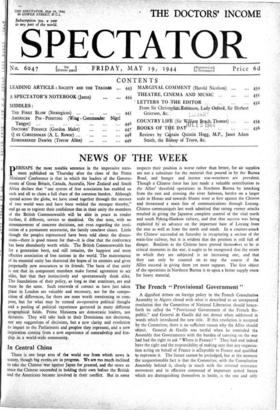In Central China
There is one large area of the world war from which news is scanty, though big events are in progress. We are too much inclined to take the Chinese war against Japan for granted, and the more so since the Chinese succeeded in holding their own before the British and the Americans became involved In their conflict. But in some
respects their position is worse rather than better, for air supplies are not a substitute for the material that poured in by the Burma Road, and hunger and intense war-weariness are prevalent. Though a Chinese force has just made a valuable contribution to the Allies' threefold operations in Northern Burma by 'attacking from the east and crossing the river Salween, battles on a larger scale in Honan and towards Shansi went at first against the Chinese and threatened a main line of communications through Loyang. Chinese communiqués last week admitted that strong enemy attacks resulted in giving the Japanese complete control of the vital north and south Peking-Hankow railway, and that that success was being exploited by an advance on the important base of Loyang from the rear as well as from the north and south. In a counter-attack the Chinese succeeded on Saturday in recapturing a section of the main-line railway, but it is evident that the position is still full of danger. Resilient as the Chinese have proved themsoives to be at critical moments in the war, it ought to be recognised that the strain to which they are subjected is an increasing one, and that they can only be counted on to stay the course if the Allies succeed in giving them yet more support. The first object of the operations in Northern Burma is to open a better supply route for heavy material.


























